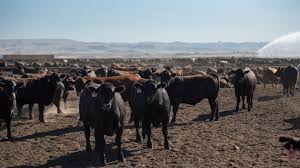In early February 2025, the Texas beef cattle herd experienced a modest increase, reaching 4.02 million head, up by 60,000 from the previous year. Despite this growth, the overall U.S. beef cattle herd remains near its lowest levels since 1961, with a 0.6% decline to 27.68 million head. This slight expansion in Texas is a rare positive development amid ongoing industry challenges, reflecting both the resilience and caution of cattle ranchers in the region.
Cattle ranching is a fundamental part of Texas’ agricultural economy, and shifts in herd numbers can have significant economic implications. The current landscape is shaped by several key factors, including high beef prices, rising input costs, and persistent drought conditions. These variables influence herd expansion decisions, market strategies, and profitability for ranchers across the state and the nation.
Factors Affecting Herd Growth
Several factors are influencing the rebuilding of the Texas beef cattle herd, some encouraging expansion while others present significant challenges.
High Beef Prices
One of the primary drivers of herd growth is the surge in beef prices. The Southern Plains market, which includes North Texas and Oklahoma, saw 400-500-pound calves averaging $3.89 per pound, a significant increase from $3.29 per pound the previous year. This spike in prices has encouraged some ranchers to consider rebuilding their herds, as higher market values offer the potential for increased profitability.
However, while high beef prices present an opportunity, they also reflect broader supply chain pressures, including lower overall cattle numbers, increased consumer demand, and fluctuating feed costs. The ability of ranchers to capitalize on these high prices depends on their capacity to manage the rising costs associated with cattle production.
Increased Input Costs
Despite the financial incentives provided by strong beef prices, ranchers face mounting operational expenses. The costs of feed, equipment, labor, and veterinary care have risen considerably, making herd expansion a costly endeavor.
- Feed Costs: Drought and supply chain issues have led to increased prices for hay and grain, key feed components for cattle. Many ranchers who depend on supplemental feeding due to limited pasture availability are finding it difficult to justify herd expansion.
- Equipment and Fuel: The cost of maintaining and purchasing farm equipment, as well as transportation expenses for cattle, has surged due to inflation and supply chain disruptions.
- Labor Shortages: Finding and retaining skilled labor for ranching operations has become more challenging, further adding to operational burdens.
For many ranchers, these increased input costs offset the financial benefits of high beef prices, leading them to adopt a cautious approach to herd growth.
Drought Concerns
Ongoing drought conditions in Texas continue to be a significant factor affecting cattle ranching. Reduced water availability and poor forage conditions have made it difficult for some ranchers to sustain their herds, forcing them to sell off cattle rather than expand operations.
- Forage Quality: Poor rainfall has led to lower-quality grazing pastures, necessitating additional feed supplementation.
- Water Scarcity: Limited water sources for cattle can impact overall herd health and reproductive rates.
- Climate Uncertainty: With unpredictable weather patterns, ranchers are hesitant to invest in expansion without confidence in long-term pasture viability.
These drought-related issues have led many cattle producers to prioritize efficiency over growth, opting to manage smaller herds more effectively rather than increasing herd sizes amid uncertain conditions.
Market Dynamics
The broader beef cattle market is experiencing record-high prices, but the increasing costs of raising cattle pose significant challenges. The average price for 800-pound steers in 2024 was $247.43 per hundredweight, a 14.7% increase from the previous year. While this reflects strong demand for beef, it also highlights the inflationary pressures affecting the industry.
Market volatility remains a concern for ranchers. Although high beef prices provide opportunities for greater revenue, there is always the risk of price fluctuations. Trade policies, global economic trends, and consumer behavior shifts can all impact market stability.
- Consumer Demand: Rising beef prices may lead to reduced consumer demand or shifts toward alternative proteins.
- Export Markets: International demand for U.S. beef influences pricing, but geopolitical factors can affect trade agreements and exports.
- Economic Uncertainty: Inflation and economic downturns could reduce discretionary spending on premium beef products, potentially impacting cattle prices.
Given these uncertainties, many ranchers are taking a measured approach to herd expansion, balancing potential profit gains against economic risks.
Rancher Perspectives
Ranchers remain cautiously optimistic about the future. Many are implementing strategic measures to navigate the complexities of the current market.
- Herd Management: Some are focusing on maintaining smaller, high-quality herds to maximize efficiency and profit margins.
- Genetic Improvements: Investing in better breeding stock to produce higher-value cattle with improved growth rates and meat quality.
- Forage Optimization: Exploring alternative forage strategies, such as rotational grazing and improved pasture management, to mitigate drought effects.
Despite the challenges, the resilience of Texas ranchers continues to drive industry sustainability. Those who can adapt to changing market conditions while efficiently managing costs and resources stand to benefit the most from the current cattle industry landscape.
Conclusion
While the Texas beef cattle herd has seen slight growth, the overall U.S. herd remains near historic lows. This limited expansion highlights the cautious optimism among ranchers who must balance the opportunities of high beef prices with the challenges of increased input costs and persistent drought conditions.
Looking ahead, the trajectory of the cattle industry will depend on various factors, including weather patterns, economic conditions, and policy developments. Ranchers will continue to navigate these challenges with strategic decision-making, focusing on sustainability and profitability. Despite the hurdles, the Texas cattle industry remains a cornerstone of the state’s agricultural economy, demonstrating resilience and adaptability in the face of evolving market dynamics.
Disclaimer – Our editorial team has thoroughly fact-checked this article to ensure its accuracy and eliminate any potential misinformation. We are dedicated to upholding the highest standards of integrity in our content.





More Stories
Texas Beef Herd Sees Modest Growth Amid Record-High Prices
Texas Beef Herd Sees Modest Growth Amid Record-High Prices
Texas Beef Herd Sees Modest Growth Amid Record-High Prices